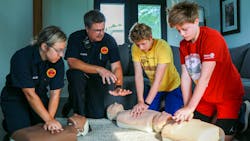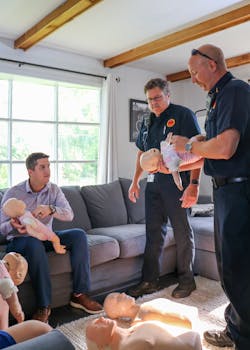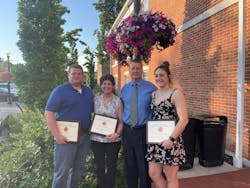Every year, approximately 350,000 people experience out-of-hospital cardiac arrests. Alarmingly, approximately 90 percent don’t survive.
This staggering statistic hangs over the heads of most EMS professionals.
With the odds stacked against us, it’s time for every fire department to activate an untapped fleet of helpers: their very own residents. This is the principle behind the Westerville, OH, Fire Division’s “Street-by-Street” resident training program. It offers noncertification CPR, basic first aid and other emergency response training on the neighborhood level.
Our comrades in law enforcement and national security tout the motto, “See Something, Say Something.” I present that we also should encourage our communities to “See Something, Do Something.” We, as emergency responders, have a unique opportunity to empower residents to take action.
According to the American Heart Association (AHA), immediate CPR can more than double a cardiac-arrest patient’s chance for survival. In Westerville, we recently witnessed firsthand the splendid effect of bystanders who are willing to help a person who is in need:
Mr. Corban was riding his bicycle to get a little exercise. It had been a good ride, and it felt nice to him to be active on such a lovely day. Near the end of the ride, he sprinted up a small hill. He recalled later that’s the last thing that he remembered. What he doesn’t remember is falling off of his bike headfirst and cracking his helmet when he hit the ground. He lie there lifeless until three bystanders rushed to his side and immediately started administering compressions. They worked together, continuously pushing hard and fast on his chest until our crew arrived to assume care. Corban remained unresponsive, and Westerville’s responders continued compressions with the Lucas device and an advanced airway; multiple shocks and medications were administered en route to the local emergency department. It was discovered that he had a 100 percent occlusion of one of his arteries and needed to go to the catheterization laboratory. Eventually, after the procedure and cooling protocol, Corban regained consciousness and began a miraculous recovery, with no neurological impairment, thanks to early intervention from the three bystanders.
Removing barriers
I have taught CPR classes for about 20 years to citizens, other healthcare providers, friends and family. I love knowing that these hands-on learning opportunities can transform bystanders into lifesavers. The learning builds on itself and puts together how to respond to an emergency situation. As uncomplicated as it sounds to us as emergency responders, the barriers to acting in an emergency aren’t mitigated easily by these certification classes. Research shows a great reluctance on the part of bystanders to jump in during an emergency.
Before I go further, I want to make one thing abundantly clear: We should continue to promote, support and encourage all individuals to pursue official certification through the AHA and other reputable organizations. AHA classes provide an in-depth experience that offers the opportunity for repetition and place-specific training.
Street-by-Street isn’t intended to replace certification training but, rather, reach residents who wouldn’t otherwise think to or be able to learn basic lifesaving skills: Think about older adults who are unable to leave ailing partners or parents, busy parents who have young children, grandparents who are preparing to watch their grandchild during the week, etc.
So, how do we get more people to act in an emergency? First, make it as simple as possible. Second, access larger audiences by going beyond the certification classes. Third, show them how they fit into something that’s bigger than themselves.
Science has caught up to us in my time as a first responder and determined without doubt that the most important thing to do for a cardiac-arrest patient is chest compressions. It’s a huge stride toward keeping it simple for the general public. Tell them, “If you forget everything else, call 9-1-1 then push hard and fast on the person’s chest if they aren’t breathing or not responding.” It allows us to drop from the lesson the elements of CPR that can make it more complicated for average citizens to act. In other words, remove barriers by focusing on hands-only CPR to increase the likelihood that the average citizen will act.
Beyond the certification class
Stop only offering certification classes in your firehouse. Go into the community and get in front of more people. We must teach everyone, not just those who need a certification card for their workplace.
The Street-by-Street training concept was developed five years ago when I worked in a neighboring community’s fire division, and I am in the process of introducing it to Westerville. The premise is to teach CPR to everyone who is in the community, street by street.
In one of my very first classes, I was welcomed into the home of a woman who, some time before, found a man who was in distress on a park bench. She realized that he needed help but didn’t know what to do. She froze, racking her brain trying to remember all of the things that she learned long before in a CPR class. She became afraid that she would do something wrong, so she didn’t do anything to help. Unsurprisingly, this incident disturbed her deeply.
Afterward, she called the firehouse. I recognized that she needed to talk and that I needed to listen. She and I needed to find a positive solution, so we scheduled a class in her home with eight other women, and a medic unit would bring CPR manikins and an automated external defibrillator trainer.
Soon after, a small crew of firefighters was in her living room, spending time with her group of friends and teaching them how to recognize an emergency, how to get help and how to do something. The crew focused on compressions. The group of friends shared stories, laughed and learned.
In the end, the first responders built trust and new relationships. They converted residents into fans and bystanders into potential lifesavers. The ladies asked questions about emergencies but also about the firefighters, their jobs and the department. The firefighters shared the good work of the department and interacted on an interpersonal level that isn’t afforded on an emergency call. (They also were able to install a new smoke detector.)
Think about the effect of going to a gathering of neighbors for a barbecue or to a home of new parents, with both sets of grandparents present, to teach them infant CPR. Each of these interactions builds good relations between department and citizenry and increases the likelihood that someone will act in an emergency.
Assessing your gaps
When I came into my new role as Westerville’s EMS operations chief, I told the team that we were going to baseline what we do, so I could see where we were starting and where we needed to improve.
From a community lens, I wanted to focus on improving cardiac survivability. If you live in our response area, I wanted you to have a greater chance of walking out of the hospital after the incident.
The first thing that I did was to join Cardiac Arrest Registry to Enhance Survival (CARES). This resource helps communities to create standard outcome measures for out-of-hospital cardiac arrests, which allows for quality improvement efforts and benchmarking capabilities to improve care and increase survival.
The second thing that I did was look at our data in our response software, ESO, to learn the frequency of cardiac arrests and to identify common themes and challenges. Then, I tested Stryker’s Code-Stat data review program. The program provides performance feedback for response crews after cardiac arrests. This allowed us to improve our speed of applying the Lucas device as well as to minimize pauses.
The next thing that I did was review cardiac arrests with our dispatchers, to improve recognition of these events and to help to increase confidence in giving pre-arrival instructions to whomever.
In every CPR class that I teach, I look my students in the eyes and tell them that what they do before we get to the scene of a cardiac arrest matters the most in that patient’s outcome. I challenge them to “do something” in an emergency, and I keep my instructions simple: Push hard and fast on a person’s chest. If your department uses the Pulse Point 9-1-1-connect app, show them how to register and receive alerts.
I challenge all of you to reframe how you view the citizens in your community. With lives on the line, we can’t afford to leave untold numbers of potential lifesavers unactivated. It starts with understanding how your community is performing in regard to out-of-hospital cardiac arrests.
See if you can close the gaps. See that all of the links are interconnected and important. Get your firefighters into citizens’ homes. It’s good for your department, and, most importantly, it saves lives.
About the Author
Mindy Gabriel
Mindy Gabriel is the deputy fire chief in charge of EMS operations for the Westerville, OH, Fire Division. She oversees EMS emergency operations, tactical EMS, outreach education, training, quality improvement and a community paramedic pilot program. Gabriel serves as the department's infectious control officer. Previously, she served 17 years with the Upper Arlington, OH, Fire Division. Gabriel’s background in community EMS services and working with fellow firefighters as a peer counselor includes developing innovative programs for a changing fire-based EMS service. She has a bachelor’s degree in education from The Ohio State University.


